I am hip-deep in designing the shawl borders, with Knit Visualizer, Photoshop, and CorelDraw to help me out.
Here's the math. The inner square is 179x179 stitches. The outer border is centered on 50 stitches, so that 99 stitches is a full mirror repeat. I therefore need 198 stitches to begin the outer border.
If I do a YO every other row at the corners, I'll need about 20 rows of knitting to get to 190 stitches.
I looked at the slapped-together composite, and decided that, because both the center and the outer borders are quite busy, the inner border should be a bit restful.
Here are two choices. The first one is a simple, linear strip, while the second offsets the little motif to add just a bit of movement.

I am leaning towards the second choice, mainly because I dislike static stripes. And it sort of looks like bouncing, baby spiders to me.
Wednesday, February 28, 2007
Black Widow Spider Queen Inner Border
Posted by
fleegle
at
11:58 AM
4
comments
![]()
Labels: Black Widow Spider Queen shawl, Knitting, lace
Shawl Borders: A Third Method
As I begin the design of the Black Widow border, I am also thinking about the general construction. There are several ways to assemble these shawls, but the two methods under consideration are:
1. Pick up all the stitches around the four sides and knit circularly. This method requires purling every other round to keep the garter stitch background correct.
2. Pick up all the stitches and knit around, turn and knit back. This method requires grafting the fourth corner upon completion of the border.
As I wandered around the Web this morning, I found this very interesting post describing another method of working a Shetland border. The author of these posts works the fourth corner with a clever trick, so the entire border can be knit around, but there is, in fact, no grafting required.
There are two links: here and here. The first has the description, the second, the pictures.
Tell me what you think. I may swatch this in heavier yarn and see how it works.
Posted by
fleegle
at
9:09 AM
4
comments
![]()
Labels: Black Widow Spider Queen shawl, Knitting, lace, tips
Tuesday, February 27, 2007
Black Widow Spider Queen as Stuffed Cabbage
Years ago, I decided to make stuffed cabbage for dinner. As I assembled the ingredients, I noticed that I didn't have any cabbage, nothing much for stuffing, and not a drop of tomato sauce in the house. I ended up using spinach, cornmeal, sausage, and salsa. The end result was actually quite tasty, but didn't exactly conform to the standard stuffed cabbage we all know and love (or not, as the case may be).
So, as I cruise through the final repeat of the Black Widow center, I am starting to critically examine the original border. I don't like it. The first row of thingies, which are supposed to be crowns, actually look like cartoon aliens to me. The wiggly border is just awkward and way too thick for the little flowers on the outside. And that Franken-seam! Why?
I also notice the chart presentation is called "boustrophedon," which is apparently Ancient Egyptian for "causing your head to explode because I am too cheap to buy enough papyrus to write out the entire pattern."
Setting aside the boustrophedoned aliens, I turn to other ingredients in my pattern cupboard. And lo! There is some sausage here. This is the border of Mondnacht. Curiously and fortuitously, it's written with knit and purl rows--perfect for working in the round on a garter-stitch center. A little Photoshopping...
This is the border of Mondnacht. Curiously and fortuitously, it's written with knit and purl rows--perfect for working in the round on a garter-stitch center. A little Photoshopping...
And we have a tasty dish of stuffed cabbage!
Now all I have to do is work out the math. And fiddle the corners. But you get the idea. I may cave, if it turns out to be impossible, but I really like this assembly better than the original.
Posted by
fleegle
at
10:19 AM
6
comments
![]()
Labels: Black Widow Spider Queen shawl, Knitting, lace
Sunday, February 25, 2007
Asheville Report
It wasn't exactly Stitches West, but we had a Genuine Eye Candy weekend, and not just for yarn. Anyone familiar with Asheville knows it's one of the most artisan-rich areas in the United States. It seems like every other shop showcases exquisite craftsmanship--glass, fiber, wood, photography, jewelry, sculpture, and some really impressive beer-cap mosaics. I wonder what the artist did with the bottles....
Yarn Paradise (aptly named) was right around the corner from our hotel. Roy adopted this luscious Claudia hand-dyed mohair boucle. He sat in the Husband's Corner with it possessively wedged under his chin. A Car-Knitting Scarf, he declared, refusing to release it.
I know I promised I wouldn't post any cat pictures, but Laptop seems to feel the same way about this skein of yarn as Roy does. She usually ignores yarn, so I caved and snapped her possessively clutching the mohair.
Two skeins of Koigu and some buttons destined to be made into cuff links were the only other purchases.

I know there are some of you who like Purl, but I really don't care for this store. The Husband's Corner featured an agony-inducing rocking chair and a back-wringer with a broken seat.
The lighting is awful and the yarn arranged by color, which I find totally unintuitive. I don't shop by Blue or Green. I shop by Shawl or Sweater, or at least by Fingering or DK. And this store had no squashy, fondle-friendly yarn anywhere--it was all scratchy, bulky woolly stuff with some googly novelties for the Scarf Set. And like the last time, I attained invisibility as soon as I stepped over the threshold.
The Earth Guild had it's usual vast array of fiber-related goodies, but nothing jumped out at me except one of the owners. We reminisced about their original store in Cambridge and she filled me in on thirty years of gossip about people I never knew or couldn't recall. At least I wasn't invisible.
Of course we had dinner at the Flying Frog Cafe. Where else to eat after a tour of yarn stores?
Nobody had any Addi Lace needles yet and it was a bit too early for Spring yarn. And the books! Why do the publishers bother thinking up titles? Call them all Simple Chunky Funky One-Skein One-Hour Brainless Non-Grandmother's Knitting for Cool Teens Volumes 1-456.
What I want to see is a book titled Wickedly Intricate Knitted Masterpieces for the Really Experienced Lunatic Knitter.
I envision this book to be a cross between Miller's Heirloom Knitting and that Japanese masterpiece, New Style of Heirloom Knitting, with some whimsical additions to leaven the weighty, serious, complex projects that comprise the remainder of the book. There will be ample photographs and a sturdy text font readable by any age group without squinting. The book shall be printed on non-shiny paper and contain no How to Cast On/Knit/Purl section. And in the back of the book there will be a CD holding an e-book version to take on the road, plus a folder full of enlargeable graphs.
In my dreams.
Posted by
fleegle
at
7:13 PM
15
comments
![]()
Labels: Knitting, yarn stores
Non-Knitting Knitting
For those who bought the perfect yarn for a scarf, but don't want to actually knit it, you can go here and avoid all that needle-fiddling/knit/purl business.
Posted by
fleegle
at
5:07 PM
3
comments
![]()
Friday, February 23, 2007
Knit your own brain-sucking alien in ten minutes or less!
We all know that knitting gauge is defined as stitches per inch. If you go here, you can see knitting gauge at inches per stitch! Serious fiber horror, folks.
I especially enjoyed the orange pumpkinhead scarf/hat/brain-sucking alien, but I am sure you will find your own favorite, um, garment?
Posted by
fleegle
at
3:59 PM
8
comments
![]()
Wednesday, February 21, 2007
Shawl Updates
As you can see from the wrinkly picture below, two repeats of the Black Widow Spider Queen shawl are now complete, and I am well into the third of four repeats. Nothing of any note to report--no dropped stitches, no tinking, no frogging, and no cat-claw snags (thank you, Laptop).
I am fiddling around with the border patterns, because I will be knitting them in-the-round to avoid the Franken-seam that grotesquely deforms the original. When I have the process all worked out, I will post the instructions, in case anyone wants to follow in my tottering footsteps.
And here's a pix of my Dragone border. I am a quarter around at this point, and am very pleased with the dragon-scaly look.
For those who wish to further totter along with me, here is the chart of the border pattern. The even-numbered rows are purled, so don't forget row 16, ok?
This weekend, we are taking a break and driving up to Asheville, North Carolina. Talk about target-rich environments! When I Googled for Yarn Stores in Asheville, I got 220 hits! After I stopped hyperventilating, I grazed through the results and found that most of them were typical goofy seach returns. But there were 15 genuine yarn stores in the area, so I will be busy pinching and poking, hoping in vain to find yarn for Mountain Ash.
Poor Mountain Ash. So far, I have considered and rejected about seven different yarns, including one that was supposed to be hand-dyed to a submitted sample. The dyer overdid the green (it's a bit too minty-fresh for me), so I had her overdye that to dark blue. Now I have 2500 yards of lovely silk merino lace for something, but not, alas, Mountain Ash.
Posted by
fleegle
at
12:00 PM
13
comments
![]()
Labels: Black Widow Spider Queen shawl, Heere Be Dragones Shawl, Knitting, lace
Friday, February 16, 2007
Software for Knitters: Part III: Image Editors
Most of us now own a digital camera, right? Some of us might even own two. Or three. And a scanner. Or two. Don't start. There's a reason I own all this stuff and most of it has to do with work. Really!
Even the most economical scanners and cameras ships with some sort of software to tweak your pictures. And, regardless of your operating system, there are an astounding assortment of free or really cheap image editors available, many of which can be downloaded from the Web.
For example, this site lists freebies and you can find a list of budget programs here. If you don't like any of those, a short session Googling "Image Editing Shareware" will keep you busy for a week or two.
I use Photoshop almost exclusively as my primary image editor, although I occasionally fool around with both Corel PhotoPaint and PaintShop Pro. My examples are described in Photoshoppy talk, but most of these sorts of edits can be performed in virtually any image editor.
My most common task for Photoshop is inverting and compositing charts. Some people can read charts backward and forward with equal facility, flipping increases and decreases at will. I can’t. So when I have a lace chart that tells me to work from left to right to the center point, then work from right to left, reversing decreases, I scan it, then make a copy, flip it over, and match it to it’s other-handed clone. This quick and easy maneuver produces a lace chart I can actually follow without my head exploding.
Here's a quick example (it's only a fragment of the actual chart) The bottom chart was just horizontally flipped. When I knit this item, I worked the top chart, then instead of trying to work it backwards, I merely shifted my eyeballs to the lower chart and continued to work from right to left.
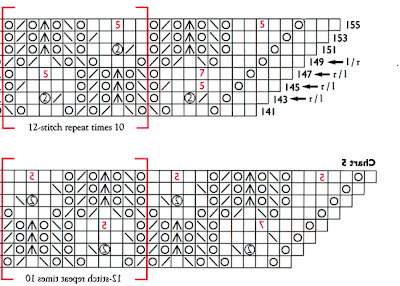
Mountain Ash, a shawl of exceptional loveliness, has been on my To-Do list for months now. Getting started with it has been fraught with difficulty. First, the pattern is in Japanese. Second, one of the graphs is missing a big chunk. And third, the printed graph is so tiny that it needs an electron microscope to even see the teensy-beensy type.
So, the first thing I did with Mountain Ash was scan in the graphs and enlarge them for human eyes over 40 years of age.
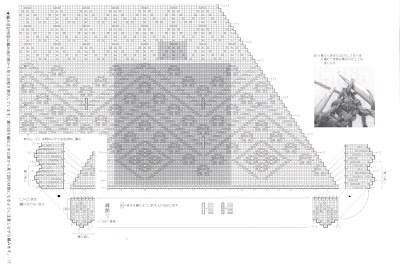
Then I cut and pasted sections of the chart together into something that I could actually read. The decreases are fetchingly reversed so I don't have to think about it.

I also use Photoshop to composite lace designs, that is, cutting and pasting specific areas of charts and rearranging them to suit. Image editors make it easy to produce new lace patterns in a flash, once you know a few basic techniques. In the case of Mountain Ash, I wasn't happy with the arrangement of some of the elements, so I modified the graph, cutting and pasting the little flowers at the top into a more pleasing arrangement.

Image editors can also be used as colored glasses. Don’t like the color of the sample project? It’s easy enough to change the hue in a program like Photoshop. I often use it to see what effect overdying will produce on a yarn whose original color wasn’t exactly what I’m looking for (translation: The color photo on the Web store was wildly different from the actual yarn).
Here’s a perfect example of using Photoshop as rose- (or any other color) glasses.
First, of course, I scanned in the picture from the book.
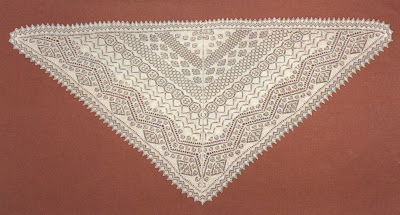
Then I selected the background using the Select/Color Range command and deleted it. Before I deleted the background selection, though, I inverted the selection, so only the shawl is selected, and saved the selection so I could reuse it later.

Here are some Mountain Ash variations.
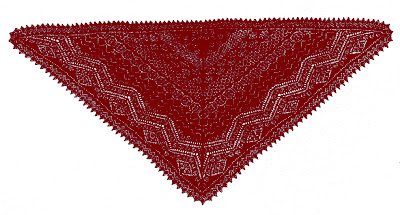
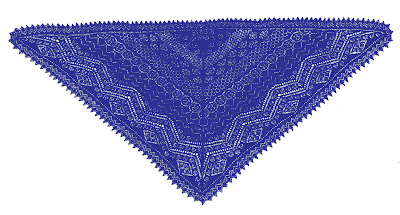 And you can change the background to black to make light colors more contrasty:
And you can change the background to black to make light colors more contrasty: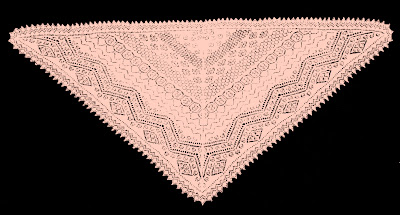
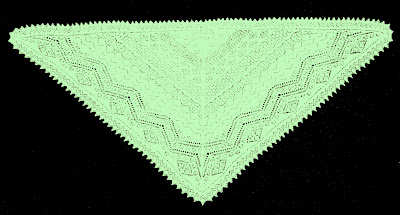

There are several other ways to accomplish the same thing. For example, you can use the Color Balance panel to add or subtract color. Or, you can use the Hue/Saturation panel. This panel is especially useful, as you can slide through all the colors of the rainbow, while adjusting the color intensity and lightness. Or you can grab a brush and start painting on color. And you can even apply a gradient if you want to see if your handpainted silk will obscure the pattern:
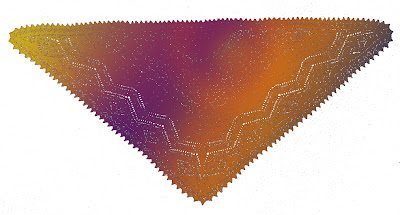
Finally, because this post is becoming longer than most people want to read (and I wanted to write :)), you can use an image editor to virtually design and knit something. For example, you decide you want to knit some flowers and plop them on a sweater. You don’t have to buy yarn or knit either the sweater or flowers to see a finished result.
Here is a plain pink sweater that I scanned out of a yarn catalog.

And here we have a pink flower that I scanned out of a book:
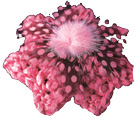 Put them all together in Photoshop....
Put them all together in Photoshop....
Do a resizing and rearranging:
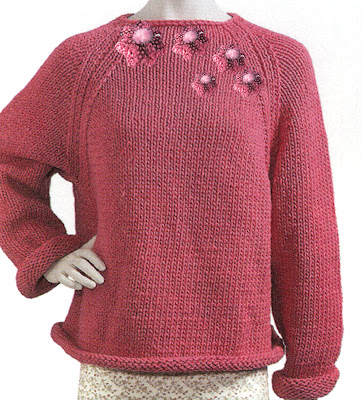
And in 20 minutes, you can have a really good idea of what the final result will look like, all without leaving the comfort of your computer room.
Invest in an inexpensive (or expensive) image editor and you will find a multitude of knitting experiments suddenly become easy to do. Of course, you can also use the software to add a moustache to your mother-in-law, see what your least-favorite politician would look like wearing a dress, and other engaging pastimes. Not, of course, that I do things like that. Much.
Posted by
fleegle
at
1:16 PM
9
comments
![]()
Wednesday, February 14, 2007
Happy Valentine's Day!
I'll be willing to bet none of you guys received a heartmeltingly appropriate gift like THIS for Valentine's Day:
Tink is wearing the Dragone shawl--it nicely compliments the variety of lips he is displaying.
Hope you had a good one, too!
Posted by
fleegle
at
10:18 AM
6
comments
![]()
Monday, February 12, 2007
Heere Be Dragones Journal--Border Swatch
I finished the body of the Dragone shawl a few days ago, and have been puzzling about the border ever since. The original border just didn't work for me. It was a bit too sloppy looking and the join looks, um, maybe not so smooth. And I didn't care for the top shaping, either. Here's Sharon's original shawl:
So I spent a few hours coming up with my own border design.
I wanted something that resembled dragon scales, and I think this does. The right side is an adaptation of an Estonian lace pattern; the left side is an adaptation of one of Kinzel's edgings. I kind of blended them together with a column of YO/K2tog. I am going to sit on it (well, not literally) for a few days, leaf through my books some more, and see if another pattern jumps out at me.
Posted by
fleegle
at
12:34 PM
6
comments
![]()
Labels: Heere Be Dragones Shawl, Knitting, lace
Spider Queen Color Variations
I just love Photoshop! With a quick whisk of a wand and brush, you too can visualize your knitting in any color you like. For example...



This is soooo much easier than actually swatching. I am in love with the dark blue, which I think might work for the Unst shawl, The Next Lunatic Project.
Let me know if there's another color you would like me to, erm, virtually swatch.
Posted by
fleegle
at
11:50 AM
7
comments
![]()
Labels: Black Widow Spider Queen shawl, Knitting, lace, tips
Sunday, February 11, 2007
Black Widow Spider Queen Shawl--First Center Repeat Complete

I think it looks, well, stunning, actually (aside from the sloppy pin job). After the initial troubles with the spiders, I had no other problems beyond being unable to stop knitting it, as in....
Husband: Dinner's ready.
Me: Just one more row....
Later...
Husband: ....Dinner's cold.
Me: Well, then I can heat it up later, can't I?
In fact, this piece is zooming along so quickly it's a bit scary. But Shetland patterns are the simplest of all laces to knit because, in general, they are symmetrical and easy to memorize. And they use simple stitches too--no nupps, twists, wraps, or other fancy maneuvers.
In contrast, Estonian lace patterns can be quite complex, and oftentimes the YOs and decreases are very far apart, making it difficult (for me, at least) to memorize the repeat or visualize the final result.
I have to admit that I much prefer the sinuous and textural expression of Estonian patterns. At some point perhaps, I will design a Shetland-type shawl using Estonian patterns and confuse everyone, including myself.
Yes, I know, Dragone. The shawl body is complete and I have completed swatching for the border. I just blocked it, and will post later today when it is dry.
Posted by
fleegle
at
4:55 PM
3
comments
![]()
Labels: Black Widow Spider Queen shawl, Knitting, lace
Friday, February 9, 2007
Gingerbread Castle

This charming sampler is from Barbara Walker's A Second Treasury of Knitting Patterns. It's an especially good learning piece for an advanced beginner who wants to taste more complex techniques without devoting months (and dollars) to the experience. It would also be sweet knitted into the front of a children's sweater.
Of course, having knit it, I have absolutely no use for it. Won't work as as potholder, handkerchief, or tent. Into the swatch drawer with it!
Posted by
fleegle
at
10:49 AM
6
comments
![]()
Black Widow Spider Queen Recharted
One of the advantages of being oldish is that I can refer to wads of books I've collected over the years. I found this pattern in a Spanish book of lace that is clearly older than I am, and is lacking the cover as well. (My cover is still intact, more or less). It looks to be about the same as the original spider pattern, but this one knit up correctly for me, so I am using it instead. It is appropriately called Eyes of Something-or-Another (my Spanish being only marginally better than my Japanese).
Thank you, everyone, who contributed to solving my dilemma, whatever it was. I clearly didn't understand the original pattern. By the way, there's another version of the Spider Queen center out there that puts a plain row between each pattern row in the center. Weird.
Posted by
fleegle
at
9:25 AM
5
comments
![]()
Labels: Black Widow Spider Queen shawl, Knitting, lace
Wednesday, February 7, 2007
Oh Baby!
I feel like running far away from serious stuff like intricate black lace today, so I present something silly and cute in the baby clothing line:
This pattern is from the wonderful book by Melissa Matthay: Knitting Patterns by Melissa: Volume One: Babies to Toddlers.
It's not actually a book, it's a set of patterns printed on heavy cardstock, so you can pop the one you are working into your knitting bag and not have to carry around the entire packet.
Being a total sap when it comes to frogs, I fully intend to knit this delicious little item the next time I run across some Kermit green yarn:
And who could resist this little number:
Her designs are all darling, and she has volumes for various age groups. Not exactly the Spider Queen, but that's the entire point of this post!
Posted by
fleegle
at
7:46 PM
5
comments
![]()
Tuesday, February 6, 2007
Spider Queen Chart

I hope I am not breaking any laws by posting this fragment from the Spider Queen center.
If the odd rows are knit from right to left and the even rows from left to right, I get this:
If all rows are knitted from right to left, I get this:
Speculation and comments welcome! The goofed-up swatch seems much more attractive to me, but perhaps I am missing something.
Posted by
fleegle
at
12:09 PM
17
comments
![]()
Labels: Black Widow Spider Queen shawl, Knitting, lace
Black Widow Spider Weirdness
I confess myself totally baffled. When I first swatched this pattern, I made a mistake and worked the alternate rows from left to right. Of course, at the time, I didn't realize I had goofed. I thought the result was very attractive.
When I decided to actually make this shawl, however, I went back and, erm, read the directions, which specifically state that the central panel rows are all worked from right to left. All the numbers are on the right-hand side. I read the directions twice. And then again. Because the result is nowhere near as interesting or attractive as my flawful sample shown above.
Did I make yet another mistake or is it really supposed to look like this? To me, it just looks like random holes.
Posted by
fleegle
at
10:57 AM
4
comments
![]()
Labels: Black Widow Spider Queen shawl, Knitting, lace
Monday, February 5, 2007
Magical Mobcap Mystery Shawl as Microbe
The more rows I finished, the more it reminded me of something really unpleasant from my past life as a molecular biologist. Reaching back into the dim recesses of my brainware, I realized that it looked just like Serratia marcescens, a grim species of bacteria that I once found growing in an experiment. My professor freaked, I freaked, and we all spent a long day sterilizing everything in the laboratory, including my knitting needles.
Among other happy habitats, Serratia marcescens can often be found growing in tile grout. It's only positive aspect is that it's pink, although some of you will no doubt think that's a drawback.
In any case, it is now.................

Posted by
fleegle
at
3:34 PM
7
comments
![]()





